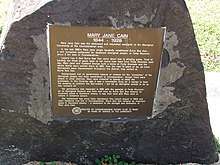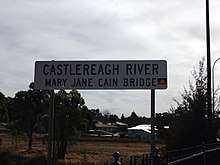Mary Jane Cain
| Mary Jane Cain | |
|---|---|
 Memorial plaque to Mary Jane Cain. | |
| Born |
Mary Jane Griffin February 18, 1844 Toorawandi Station, NSW |
| Died |
29 July 1929 (aged 85) Burra Bee Dee, NSW |
| Nationality | Australian |
| Other names | Queenie Cain |
Mary Jane Cain (1844–1929) was an Aboriginal Australian woman who lived in the Coonabarabran region of New South Wales. She was born in 1844 and was instrumental in the establishment of the Burra Bee Dee Aboriginal Reserve in 1912 and came to be known as the Queen of Burrabeedee or "Queenie Cain".
Biography
Mary Jane was the daughter of Jinnie Griffin a full blooded aboriginal woman and Irishman Eugene Griffin. She was born in 1844 on Toorawandi Station[1][2] and christened at the age of 14 on horseback [3] on the road between Coonabarabran and Mudgee.[4] After her first marriage to James Budsworth,[3] Mary Jane married head stockman George William Cain in 1865.[5][6]
Much of what is known about the life of Mary Jane Cain was recorded in oral history interviews conducted by Margaret Somerville with four of her descendents—Marie Dundas, May Mead, Janet Robinson and Maureen Sulter.[7] Somerville described Mary as "the woman who straddles two eras of history—the time before white settlement of this land and the time after. She moves between two worlds of such profound difference, and she gives her people the strength to move forward." She quotes Mary Jane, 'We gotta make it good for ourselves to go forward, the people say. How can I move across this space between Nganyinytja and me?'[8] After the death of her mother, Jinnie Griffin, in 1882, Mary became the leader of her community and was known to everyone as "Queenie" Cain.[1][2][9]
In notices published after her death, Mary's recollections were recorded of the use of Chinese labour on farms in the area before the gold rush and how after the workers departed to prospect for gold, the squatters employed local Aboriginal workers as shepherds.[3]
Mary Jane Cain petitioned the government and as a result Burra Bee Dee Aboriginal Reserve (no. 47521) was gazetted on 21 February 1912, it included a small parcel of land at Forky Mountain that had already been granted to Mary and her family by Queen Victoria.[9][10][11][12]
Mary Jane Cain died at Burra Bee Dee, Coonabarabran, NSW on 29 July 1929 aged 85.
Language
Mary Jane Cain spoke a local indigenous language, possibly Gamilaraay, and a manuscript compiled by Mary is held at the State Library of New South Wales containing wordlists of place names and the natural environment.[13][14][15]
Memorials

A bridge over the Castlereagh River in Coonabarabran was named after Mary Jane Cain. A plaque was erected by the Coonabarabran Rotary Club near the bridge in Coonabarabran to commemorate her 50 years of service to the community.[16]
References
- 1 2 "Mary Jane Cain and Forky Mountain". Coonabarabran High School. Retrieved 26 April 2013.
- 1 2 Coonabarabran High School (1987), Life on Burra Bee Dee, Development and Advisory Publications of N.S.W, ISBN 978-0-949696-40-3
- 1 2 3 "Wonderful Woman". Western Age (Dubbo, NSW : 1914 - 1932) . Dubbo, NSW: National Library of Australia. 22 August 1929. p. 4. Retrieved 3 April 2014.
- ↑ "CHRISTENED IN THE SADDLE". The Southern Mail (Bowral, NSW : 1889 - 1954). Bowral, NSW: National Library of Australia. 6 September 1929. p. 6. Retrieved 3 April 2014.
- ↑ "Obituary Mrs Jane Mary Chatfield". The North-western watchman. Arthur O. Speck. 1 August 1940. Retrieved 26 April 2013.
- ↑ Peterson, Nicolas, 1941-; Sanders, Will (1998), Citizenship and indigenous Australians : changing conceptions and possibilities, Cambridge University Press, ISBN 978-0-521-62736-8
- ↑ Somerville, Margaret; Dundas, Marie; Mead, May; Robinson, Janet; Sulter, Maureen (1994), The sun dancin' : people and place in Coonabarabran, Aboriginal Studies Press , 1994, ISBN 978-0-85575-253-8
- ↑ Somerville, Margaret (1999), Body/landscape journals, Spinifex Press, ISBN 978-1-875559-87-9
- 1 2 Wood, Marilyn (2001). "The journey to 'Forked Mountain'" (PDF). Aboriginal History. 25: 200–215. Retrieved 26 April 2013.
- ↑ Curthoys, Ann (1 October 1996). "'The privilege of being born aboriginal'". Australian Feminist Studies. 11 (24): 327–332. doi:10.1080/08164649.1996.9994830.
- ↑ "Burra Bee Dee Mission". Land and Property Information. NSW Government. Retrieved 30 April 2013.
- ↑ "Burra Bee Dee Mission". Environment and Heritage. NSW Government. Retrieved 30 April 2013.
- ↑ "Mary Jane Cain, "Reminiscences of Coonabarabran"". Discover Collections. State Library of New South Wales. Archived from the original on 23 June 2014. Retrieved 26 April 2013.
- ↑ Cain, Mary Jane. "Mary Jane Cain reminiscences of Coonabarabran, New South Wales and district, 1844-1926". SLNSW catalogue. Retrieved 30 April 2013.
- ↑ "Australian Women's History Month: Mary Jane Cain Blog post from Friday, 20 March, 2015". State Library of NSW. 20 March 2015. Retrieved 1 September 2017.
- ↑ "50 Years Service Coonabarabran Rotary Club (Mary Cain Plaque) | Monument Australia". Monument Australia (Archived in Pandora). Archived from the original on 23 May 2015. Retrieved 1 September 2017.